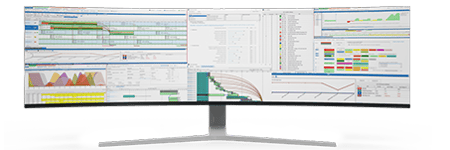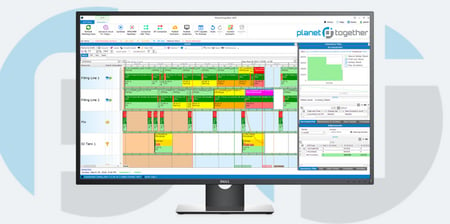Data-Driven Maintenance in Medical Manufacturing
Every piece of equipment must operate at peak efficiency, not only to maintain production schedules but also to meet stringent quality and compliance standards. A single malfunction can lead to costly downtime, production delays, and potential regulatory repercussions, making maintenance a key priority for Manufacturing IT Managers.
With the growing adoption of advanced data-driven technologies, maintenance strategies are shifting from reactive or preventive models to more predictive, data-driven approaches. Integrating platforms like PlanetTogether with major ERP systems such as SAP, Oracle, Microsoft, Kinaxis, or Aveva allows medical manufacturers to harness the power of real-time data, automation, and predictive analytics, revolutionizing how maintenance is planned and executed.
In this blog, we will explore how data-driven maintenance can transform your facility’s operations and the role of seamless integration in achieving this shift.

Data-Driven Maintenance
Data-driven maintenance leverages real-time data from equipment sensors, production schedules, and operational logs to inform maintenance decisions. Unlike traditional reactive maintenance, which addresses issues only after they arise, or preventive maintenance, which follows a set schedule, data-driven maintenance anticipates failures by analyzing patterns and predicting when equipment will require attention.
This proactive approach is ideal for medical manufacturing, where even minor equipment issues can have significant implications. By using data to predict and prevent equipment failures, data-driven maintenance minimizes unplanned downtime, reduces maintenance costs, and ensures that production remains aligned with both regulatory and quality standards.

Key Benefits of Data-Driven Maintenance in Medical Manufacturing
Data-driven maintenance offers multiple advantages that directly impact both operational efficiency and compliance:
Reduced Downtime: By predicting when equipment is likely to fail, data-driven maintenance minimizes unplanned downtime, ensuring continuous production.
Cost Savings: Maintenance costs can be managed more effectively by addressing issues before they lead to costly repairs or replacements.
Enhanced Equipment Longevity: Regular, data-informed maintenance improves the lifespan of equipment, delaying the need for capital-intensive replacements.
Improved Compliance: Maintaining equipment in top condition aids in meeting the stringent quality and compliance requirements of medical manufacturing.
Increased Safety: Predictive maintenance reduces the likelihood of equipment failures that could lead to safety hazards, protecting both operators and the end product.
![]()

Leveraging Integration for Effective Data-Driven Maintenance
For a Manufacturing IT Manager, the challenge lies not only in adopting data-driven maintenance practices but also in ensuring seamless integration between various systems. Integrating a planning and scheduling tool like PlanetTogether with ERP systems like SAP, Oracle, Microsoft, Kinaxis, or Aveva is crucial for maximizing the impact of data-driven maintenance. Here’s how integration can facilitate data-driven maintenance:
Centralized Data Collection and Analysis
Data-driven maintenance relies on a steady stream of accurate, real-time data from multiple sources, including production schedules, inventory, and equipment sensors. Integrating PlanetTogether with ERP systems allows data from across your facility to be centralized and processed in real-time. This centralized approach enables better tracking of equipment performance, allowing maintenance teams to make informed decisions and prioritize repairs based on data-driven insights.
Automated Maintenance Scheduling
Through integration, data-driven insights can trigger automated maintenance scheduling within PlanetTogether, using ERP data to coordinate with production demands. When a potential issue is detected, the system can automatically schedule maintenance during non-peak hours or align it with production breaks, minimizing disruptions. This automated scheduling also ensures that production schedules remain on track, while maintenance is conducted proactively.
Enhanced Inventory Management for Spare Parts
Integrating PlanetTogether with an ERP system allows for seamless inventory management of spare parts and supplies. When maintenance is required, the system can check the availability of necessary parts and alert the purchasing department if stock levels are low. This ensures that maintenance activities are not delayed due to unavailable parts, further optimizing uptime.
Real-Time Notifications and Alerts
Through integration, real-time alerts can be set up to notify maintenance teams of equipment that requires immediate attention. PlanetTogether can monitor data from ERP and IoT sources and notify relevant teams as soon as predefined thresholds are crossed. This proactive alert system reduces the risk of unexpected failures, enabling immediate response to emerging issues.
Historical Data and Predictive Analytics
ERP systems, when integrated with PlanetTogether, can provide historical data on equipment usage, previous maintenance activities, and breakdowns. This data can be analyzed to identify patterns and trends, creating predictive models that anticipate equipment needs. With predictive analytics, you can better anticipate failures before they happen, minimizing downtime and reducing costs.

Best Practices for Implementing Data-Driven Maintenance with Integrated Systems
To successfully implement a data-driven maintenance strategy that leverages integration, consider the following best practices:
Ensure Data Accuracy and Consistency
Data-driven maintenance depends on high-quality data. Ensure that all integrated systems are capturing accurate, consistent data, and that data flows smoothly between platforms. Data inaccuracies can lead to incorrect predictions, potentially resulting in missed maintenance opportunities or unnecessary repairs.
Establish Clear Protocols for Maintenance Alerts
Define clear protocols for handling maintenance alerts generated by the integrated system. This includes specifying response times, assigning responsibility, and establishing procedures for escalating critical issues. This clarity ensures that alerts lead to immediate action and prevent minor issues from escalating.
Train Teams on New Technologies
A successful data-driven maintenance program requires that your team understands the new systems in place. Provide training to maintenance and IT teams on how to interpret data, respond to alerts, and use the integrated system to its full potential.
Monitor and Refine Predictive Models
Predictive maintenance models improve over time with continued data input. Regularly review the performance of your predictive models, adjusting parameters as needed to increase accuracy. Refining these models will ensure that maintenance predictions remain accurate and relevant.
Align Maintenance with Production Schedules
Since medical manufacturing operates under strict schedules, maintenance activities must align with production demands. Use PlanetTogether to coordinate maintenance with production schedules, ensuring that downtime is minimized and production targets are met without compromising equipment reliability.
The Future of Data-Driven Maintenance in Medical Manufacturing
As technology continues to advance, data-driven maintenance will play an increasingly central role in medical manufacturing. Integration between PlanetTogether and ERP systems like SAP, Oracle, Microsoft, Kinaxis, and Aveva is enabling facilities to harness the full potential of their data, improving equipment reliability, optimizing costs, and enhancing compliance.
In the near future, we can expect even greater levels of automation, with AI-driven insights guiding maintenance activities and autonomous systems responding to issues in real-time. For Manufacturing IT Managers, embracing this shift means not only adopting new technologies but also fostering a culture that values data and continuous improvement.
Data-driven maintenance represents a significant leap forward for medical manufacturing facilities, moving from reactive to predictive approaches that minimize downtime and enhance reliability. By integrating PlanetTogether with ERP platforms such as SAP, Oracle, Microsoft, Kinaxis, or Aveva, you can create a comprehensive system that aligns maintenance with production schedules, manages inventory efficiently, and keeps equipment running smoothly.
As a Manufacturing IT Manager, investing in data-driven maintenance with integrated systems will not only reduce costs and improve equipment uptime but also help your facility stay competitive and compliant in an increasingly data-driven world.
Are you ready to take your manufacturing operations to the next level? Contact us today to learn more about how PlanetTogether can help you achieve your goals and drive success in your industry.
Topics: PlanetTogether Software, Integrating PlanetTogether, Medical Manufacturing, Centralized Data Collection and Analysis, Automated Maintenance Scheduling, Enhanced Inventory Management for Spare Parts, Real-Time Notifications and Alerts, Historical Data and Predictive Analytics, Enhanced Equipment Longevity




















LEAVE A COMMENT